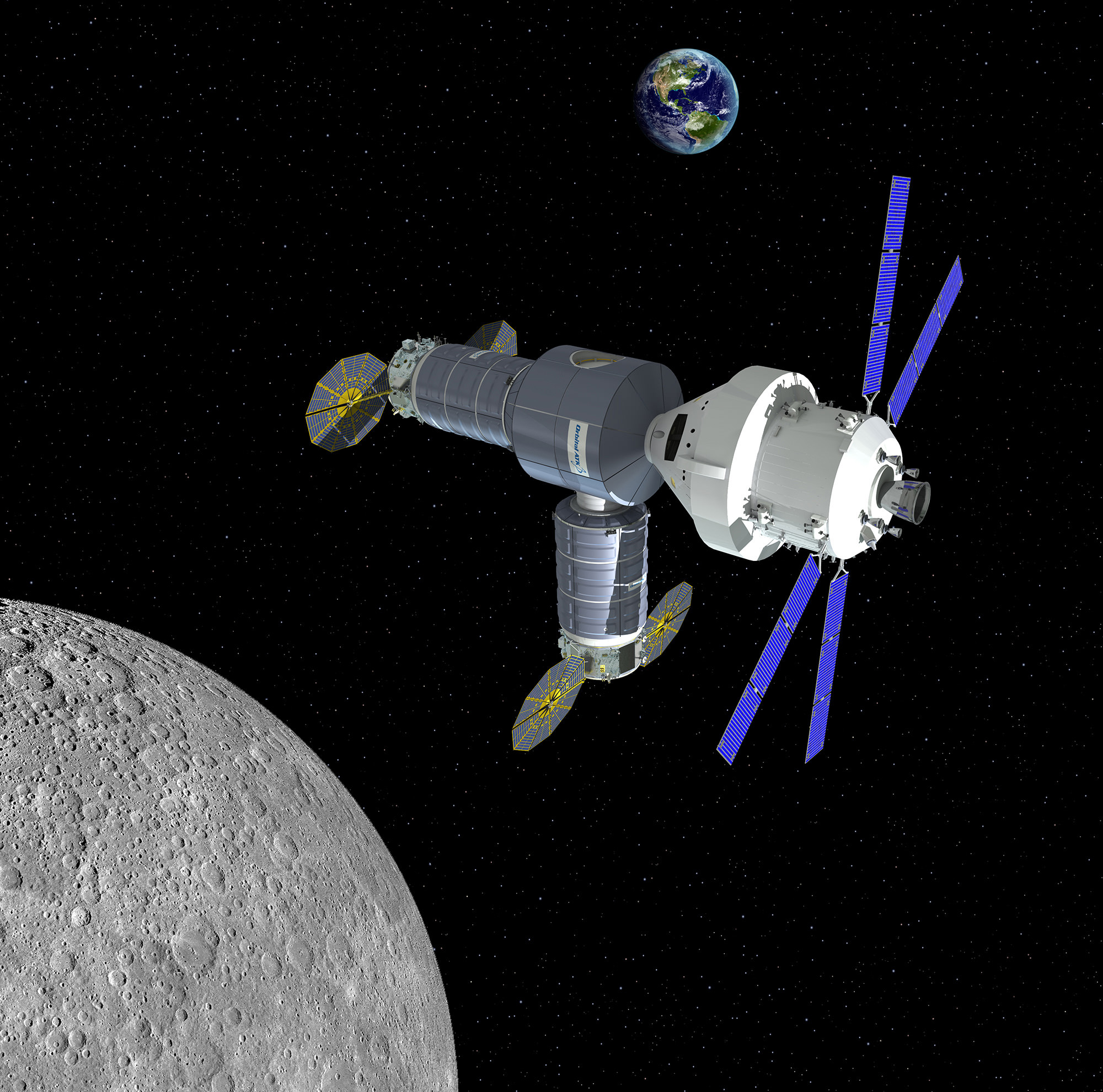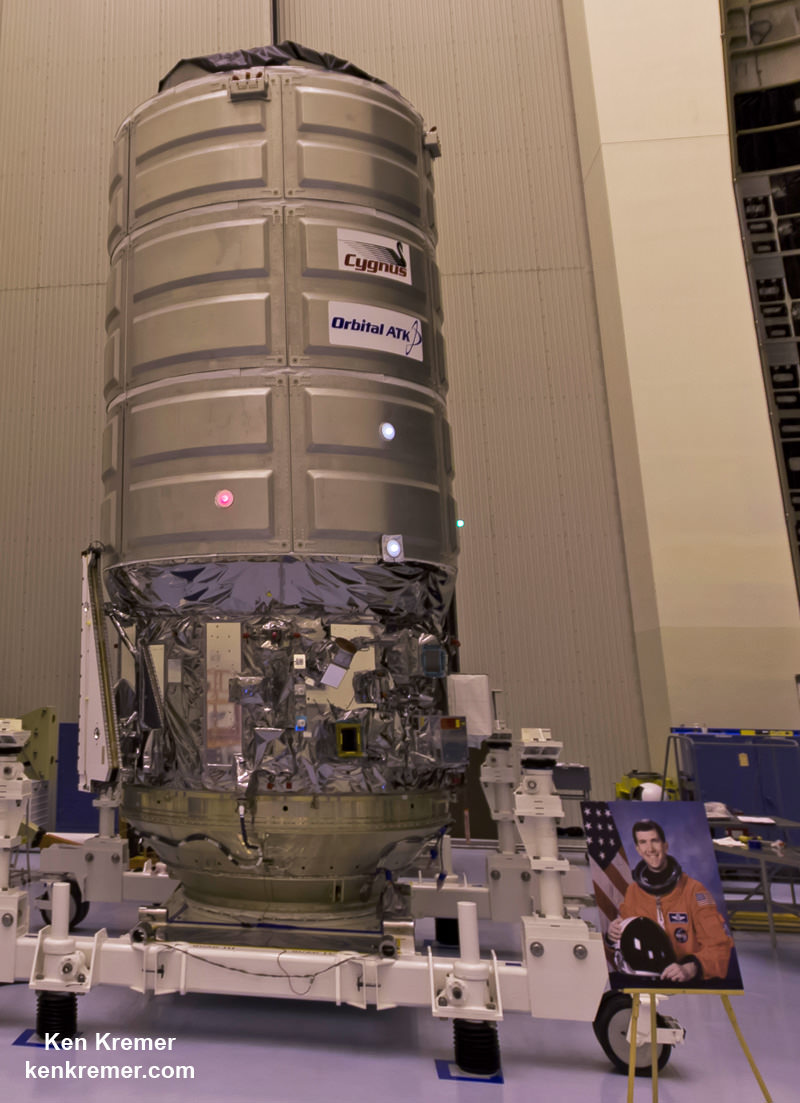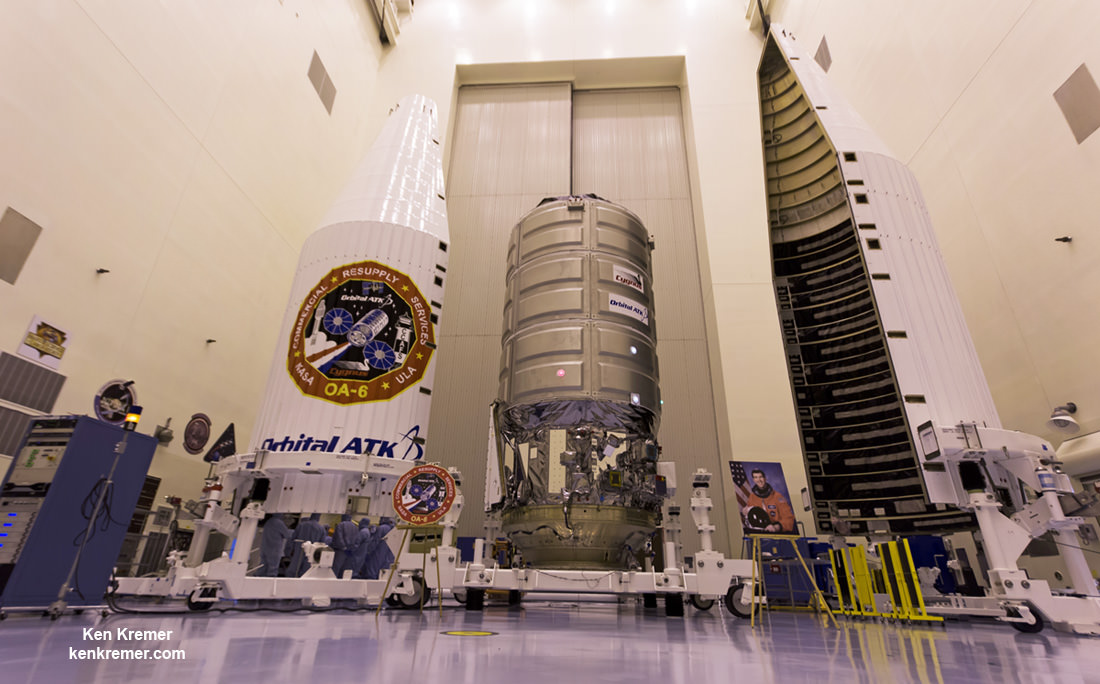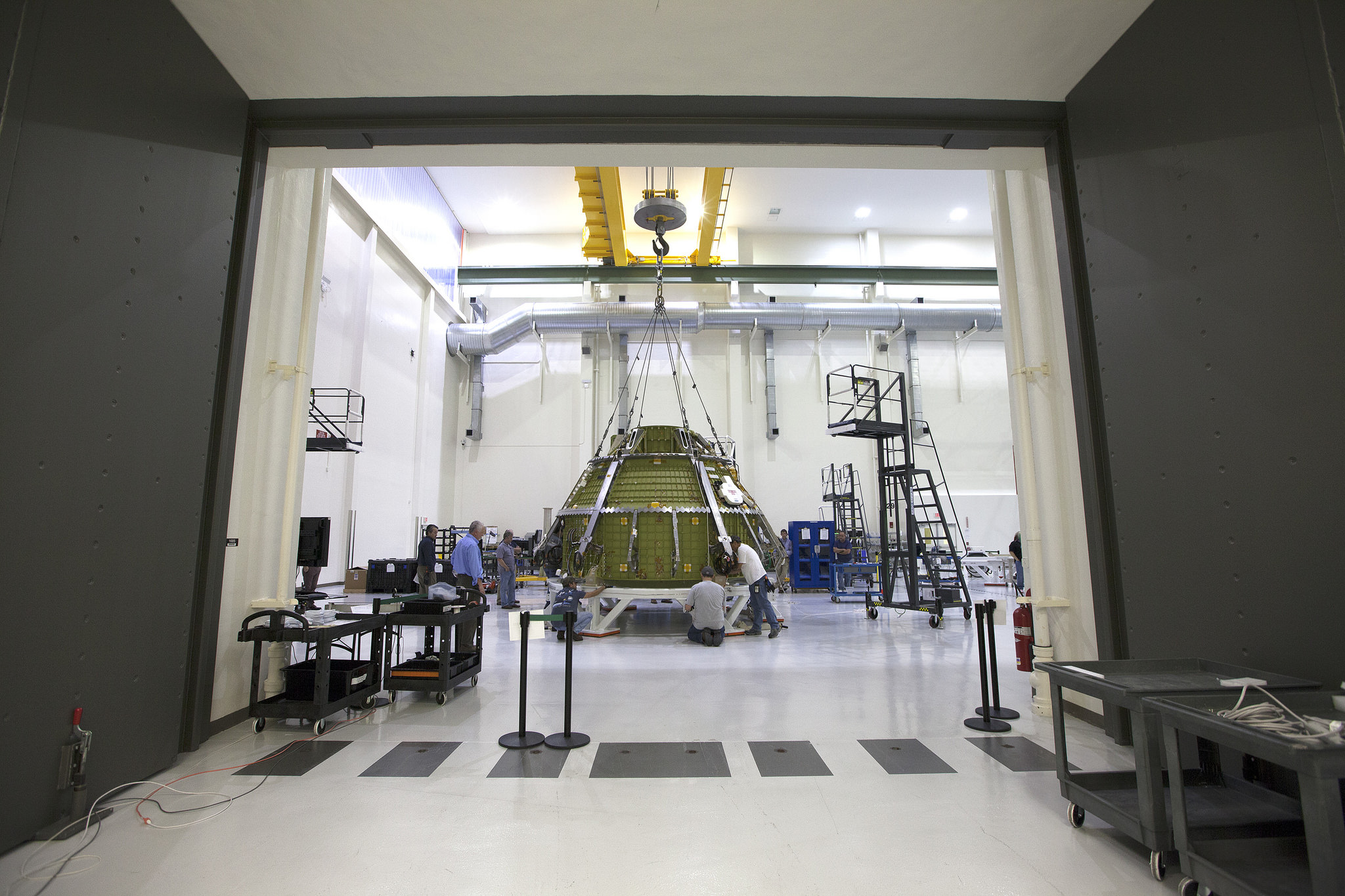
Orbital ATK has unveiled a practical new proposal to build a near term man-tended outpost in lunar orbit that could launch by 2020 and be operational in time for a lunar link-up with NASA’s Orion crew module during its maiden mission, when American astronauts finally return to the Moon’s vicinity in 2021 – thus advancing America’s next giant leap in human exploration of deep space.
The intrepid offer by Orbital could be carried out rather quickly because it utilizes an evolved version of the company’s already proven commercial Cygnus space station resupply freighter as “the building block … in cislunar space,” said Frank DeMauro, Orbital ATK Vice President for Human Spaceflight Systems, in an exclusive interview with Universe Today. See an artist concept in the lead image.
“Our Cygnus spacecraft is the building block to become a vehicle for exploration beyond low Earth orbit,” Orbital ATK’s Frank DeMauro told Universe Today.
“We are all about supporting NASA’s Mission to Mars. We feel that getting experience in cislunar space is critical to the buildup of the capabilities to go to Mars.”
NASA’s agency wide goal is to send astronauts on a ‘Journey to Mars’ in the 2030s – and expeditions to cislunar space in the 2020s serve as the vital ‘proving ground’ to fully develop, test out and validate the robustness of crucial technologies upon which the astronauts lives will depend on later Red Planet missions lasting some 2 to 3 years.
Orbital ATK’s lunar-orbit outpost proposal was announced at an official hearing of the US House of Representatives Subcommittee on Space on Wednesday, May 18, by former NASA Astronaut and Orbital ATK President of the Space Systems Group, Frank Culbertson.
“A lunar-orbit habitat will extend America’s leadership in space to the cislunar domain,” said Orbital ATK President of the Space Systems Group, Frank Culbertson.
“A robust program to build, launch and operate this initial outpost would be built on NASA’s and our international partners’ experience gained in long-duration human space flight on the International Space Station and would make use of the agency’s new Space Launch System (SLS) and Orion deep-space transportation system.”
The idea is to assemble an initial crew-tended habitat with pressurized work and living volume for the astronauts based on a Cygnus derived vehicle, and have it pre-positioned and functioning in lunar-orbit by 2020.
As envisioned by Orbital ATK, the habitat would be visited during NASA’s first manned mission of SLS and Orion to the Moon known as Exploration Mission-2 (EM-2).
The three week long EM-2 lunar test flight could launch as early as August 2021 – if sufficient funding is available.
The goals of EM-2 and following missions could be significantly broadened via docking with a lunar outpost. And Orion mission durations could be extended to 60 days.
NASA hopes to achieve a launch cadence for Orion/SLS of perhaps once per year.
Therefore autonomy and crew tended capability has to be built in to the lunar habitat right from the start – since crew visits would account for only a fraction of its time but enable vastly expanded science and exploration capabilities.
The initial lunar habitat envisioned by Orbital ATK would be comprised of two upgraded Cygnus pressurized vehicles – provisionally dubbed as Exploration Augmentation Modules (EAM). They would be attached to a multi-port docking module very similar in concept and design to the docking Nodes already flying in orbit as integral components of the ISS.

The lunar Cygnus vehicles would be upgraded from the enhanced cargo ships currently being manufactured and launched to the ISS.
“There are additional capabilities that we can put into the Cygnus module. We can make them longer and bigger so they can carry more logistics and carry more science,” DeMauro elaborated.
A variety of supplementary subsystems would also need to be enhanced.
“We looked at what systems we would need to modify to make it a long term habitation module. Since we would not be docked to the ISS, we would need our own Environmental Control and Life Support Systems (ECLSS) out at lunar orbit to support the crew.”
“The service module would also need to be improved due to the high radiation environment and the longer time.”
“We also need to look at the thermal protection subsystem, radiation protection subsystem and power subsystems to support the vehicle for many years as opposed to the short time spent at the ISS. More power is also needed to support more science. We also need a propulsion system to get to the Moon and maintain the vehicle.”
“All that work is getting looked at now – to determine what we need to modify and upgrade and how we would do all that work,” DaMauro told me.
The habitat components would be launched to the Moon on a commercial launch vehicle.
High on the list of candidate launchers would be the United Launch Alliance Atlas V rocket which recently already successfully delivered two Cygnus cargo ships to the ISS in Dec. 2015 and March 2016.
Other potential boosters include the ULA Delta IV and even ESA’s Ariane V as a way to potentially include international participation.

The habitat components could be manufactured and launched about three years after getting a ‘Go Ahead’ contract from NASA.
Orbital ATK already has an established production line flowing to manufacture a steady stream of Cygnus cargo freighters to fulfill their NASA commercial resupply contract with NASA for the ISS – accumulating know how and cost reduction efficiencies.
“Since many aspects of operations in deep space are as yet untested, confidence must be developed through repeated flights to, and relatively long-duration missions in, cislunar space,” says Culbertson.
“Orbital ATK continues to operate our Cygnus cargo logistics vehicle as a flagship product, so we are ready to quickly and affordably implement an initial Cygnus-derived habitat in cislunar space within three years of a go-ahead.”
Over time, the outpost could be expanded with additional habitat and research modules delivered by Orion/SLS, commercial or international rockets. Perhaps even Bigelow expandable commercial modules could be added later.
Cygnus is suitable for wide ranging science experiments and gear. It could also launch cubesats – like the current Cygnus berthed at the ISS is equipped with a cubesat deployer.
Potential lunar landers developed by international partners could dock at the cislunar habitats open docking ports in between surface science forays.
“We are doing science now on Cygnus and we would expect to carry along science experiments on the new Cygnus vehicle. The vehicle is very attractive to science experiments,” DeMauro explained.
“There really is no limit to what the outpost could become.”
“What we put out is very exciting,” DeMauro noted.
“As a company we are looking forward to working in this arena. Our suggested plans are in line with where NASA wants to go. And we think we are the right company to play a big part in that!”
By incorporating commercial companies and leveraging the considerable technology development lessons learned from Cygnus, NASA should realize significant cost savings in implementing its human exploration strategy. Although Orbital ATK is not divulging a cost estimate for the lunar habitat at this time, the cost savings from a commercial partner should be considerable. And the 3 year time frame to launch is very attractive.
Orion is designed to send astronauts deeper into space than ever before, including missions to the Moon, asteroids and the Red Planet. Cygnus derived modules and/or other augmenting hardware components will be required to carry out any round trip human missions to the Martian surface.
NASA is now building the next Orion capsule at the Kennedy Space Center. It will launch unpiloted atop the first SLS rocket in late 2018 on the EM-1 mission.

Stay tuned here for Ken’s continuing Earth and Planetary science and human spaceflight news.


What is all this? Celestial horseshoes? Let’s toss something 240,000 miles and see how close we can come to Moon pay dirt? Did somebody forget that all the water, He3, and mineral resources are down ON the Moon and NOT in orbit around it. Go ahead. Keep screwing around. Elon Musk and Jeff Bezos are going to be sitting on parcels they’re already mining, and colonizing, toasting each other with Krug Clos d’Ambonnay 1998, as thye watch the NASA/ATK stuck circling overhead wasting US tax dollars to achieve bupkis.
While I don’t totally agree that science conducted from lunar orbit achieves “bupkis”, I really like your comment. I believe you and I share the same frustrations regarding what NASA does – or doesn’t do – with the nearly 20 BILLION (with a Carl Segan “B”) we give them each year.
I should preface this by saying that I’ve nothing against Ken, as I think he’s one of the finest writers for UT, considering he actually makes some effort to edit his pieces. This is becoming more and more rare, and is something Matt Williams – whose articles I won’t even read anymore – would do really well to look into.
That being said “…return to the Moon’s vicinity in 2021 – thus advancing America’s next giant leap in human exploration of deep space”, is an absolute joke.
I think, “…return to the Moon’s vicinity in 2021 – thus advancing America’s next giant leap towards getting closer to re-attaining the level of capability they achieved nearly a half-century ago” rings my truth bell a little harder.
I think you and I just need to let it go. We need to just give in to the fact that “space” is no longer an issue of national pride; of government power; the intelligence of a nation; the capabilities of its people; or an indicator of said nation’s status in the world. No, “space” – much like most things in this modern world – is now an issue of private corporations, profit margins, and outsourcing.
I guess, as long as space is still “getting done”, well, as they say, “it is what it is”.
“the water, He3, and mineral resources are down ON the Moon”.
Except it isn’t, of course.
– Since Moon has no plate tectonics and above all no biosphere it has no sorted, minable minerals as we know them.
– He3 is a lunar scifi Macguffin. Fusing He3 is 100 times less efficient than fusing D. Meaning that you get the same amount of neutron irradiation/energy unit. Except that D is a vast Earth resource…
– The lunar water is at the poles, mixed in with the regolith. It would be a useful resource if painstakingly mined and thrown to LEO for space stations/rocket refueling. It has little value in lunar orbit.
1) In order to maintain a presence on the Moon, humans will have to dig in. Some digging will occur in regolith in strategic spots. Whatever gets dug, might as well be thoroughly processed for raw materials. (Also, drone miners will be put to work.)The easiest way to shelter will be to borrow into a crater wall. Since the craters at the poles are known to have water ice and 24/7/365 access to solar radiation for solar power, they will be chosen. NASA’s Mini-SAR instrument (2008-9) found approx 40 likely craters with an estimated 600 million metric tonnes of water ice. Not all the craters were polar in location. (to be cont’d)
2) You seem to have missed out on a nice Popular Mechanics article from 6Dec2004 entitled “Mining the Moon” and maybe important physics courses/lectures. Here’s a critical excerpt dealing with the evolution of fusion reactors:
1. 1st GEN: Scientists have duplicated solar fusion on Earth by using two “heavy” hydrogen atoms–deuterium and tritium–which fuse at lower temperatures than ordinary hydrogen. A 1st-gen deuterium-tritium fusion reactor operated experimentally for 15 yrs at the Princeton Plasma Physics Lab in NJ.
2. 2nd GEN: While useful for studying fusion, reactors operating with deuterium-tritium fuel are impractical for commercial use. Among other things, the reaction produces large amounts of radiation in the form of neutrons. Substituting He-3 for tritium significantly reduces neutron production, making it safe to locate fusion plants nearer to where power is needed the most, large cities. Researchers at the Univ of Wisc Fusion Tech Institute reported having successfully initiated and maintained a fusion reaction using deuterium and helium-3 fuel.
3. 3rd GEN: 1st-gen fusion reactors were never intended to produce power. Even if they are perfected, they would still produce electricity in much the same old way. That is, the reactors would function as heat sources. Steam would then be used to spin a massive generator, just as in a coal fired plant. Perhaps the most promising idea is to fuel a 3rd-gen reactor solely with helium-3, which can directly yield an electric current–no generator required. As much as 70 percent of the energy in the fuels could be captured and put directly to work.
TL: We know for a fact that humans could mine silicon, titanium, aluminum, chromium, iron, manganese, magnesium, calcium, sodium, potassium, phosphates, oxygen, sulfur, etc on the Moon. Many of these plus whatever remains of the hundreds of thousands of asteroids and comets that have collided with the Moon can be separated and refined as we dig in, and hunt for additional water ice. Probably, we wouldn’t even try to get any of the resources back to Earth. They’re too valuable up there. Hahaha, maybe we even set up a new gold repository up there–beats Ft Knox. Big money guys know this. So, do the Chinese and Russians. Why not you???
The Orbital ATK Cygnus is in the wrong location and doing the wrong mission. A good location is at the unstable location at Earth Moon L1 location for a communication relay station. This will support a Lunar Polar Base and points on the Lunar Near Side. Some items can be reused after the ISS breakup after the Russians leave the ISS program. Back to the Moon to Stay and onto Mars and Beyond-Ad Astra… tjl
How about adding a few Bigelow modules to the lunar orbiting station? Use em as bedrooms when ‘company’ drops by? While I’m at it, how about a reusable lunar lander module for the Bigelow modules and other payloads to the surface? Bigelow inflatable fuel or oxygen tank?
I am making a good salary from home $1200-$2500/week , which is amazing, under a year ago I was jobless in a horrible economy. I thank God every day I was blessed with these instructions and now it’s my duty to pay it forward and share it with Everyone, Here is I started,,,,,,
?????? http://www.BuzzWage6.com